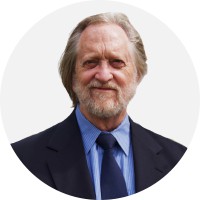The views expressed in our content reflect individual perspectives and do not represent the authoritative views of the Baha'i Faith.
While Baha’u’llah withholds from us any complete portrayal of the afterlife experience, the Baha’i writings contain a logically consistent portrait of the passage that takes us there.
By comparing the Baha’i paradigm with the experiences reported in Raymond Moody’s work on near-death experiences (NDEs)—a pattern that has since been verified by literally millions of other such reports—we can begin to understand something about what the initial stages of the afterlife might be like, and what the purpose of physical reality is in relation to that initial afterlife experience:
… the souls of the children of the Kingdom, after their separation from the body, ascend unto the realm of everlasting life. – Abdu’l-Baha, Selections from the Writings of Abdu’l-Baha, p. 193.
At the outset of his book Life After Life Moody presents a composite description of the afterlife experience, a synthesis of the elements that most commonly occur in the NDE, though not all individual experiences follow exactly the same pattern:
A man is dying and, as he reaches the point of greatest physical distress, he hears himself pronounced dead by his doctor. He begins to hear an uncomfortable noise, a loud ringing or buzzing, and at the same time feels himself moving very rapidly through a long dark tunnel. After this, he suddenly finds himself outside of his own physical body, but still in the immediate physical environment, and he sees his own body from a distance, as though he is a spectator. He watches the resuscitation attempt from this unusual vantage point and is in a state of emotional upheaval.
After a while, he collects himself and becomes more accustomed to his odd condition. He notices that he still has a “body,” but one of a very different nature and with very different powers from the physical body he has left behind. Soon other things begin to happen. Others come to meet and to help him. He glimpses the spirits of relatives and friends who have already died, and a loving, warm spirit of a kind he has never encountered before—a being of light—appears before him. This being asks him a question, nonverbal, to make him evaluate his life and helps him along by showing him a panoramic, instantaneous playback of the major events of his life. At some point he finds himself approaching some sort of barrier or border, apparently representing the limit between earthly life and the next life. Yet, he finds that he must go back to the earth, that the time for his death has not yet come. At this point he resists, for by now he is taken up with his experiences in the afterlife and does not want to return. He is overwhelmed by intense feelings of joy, love, and peace. Despite his attitude, though, he somehow reunites with his physical body and lives. – pp. 20-21.
Before Moody rehearses some of his collected accounts that describe particular parts of this pattern, he issues several caveats that become important when we compare his findings with the afterlife experience as depicted in the Baha’i writings. First, he observes that no two experiences are exactly the same. Usually an individual does not experience all parts of the model, and, conversely, no single part of the model seems to occur in every recorded experience. In addition, the sequence of the experience—the order of the parts of the model—varies from one subject to another. Another interesting observation he makes is that the clarity of the experience increases in proportion to the length of time the subject is clinically dead, though not everyone who has been clinically dead recollects an afterlife experience.
Perhaps the most important remark Moody makes prior to his presentation of the particular accounts in Life After Life is his statement qualifying the shortcomings of his sampling technique: His sampling is limited primarily to those experiences that support the pattern he had already begun to observe. In fact, in the main body of this work, Moody does not discuss or even mention those who had negative experiences.
Moody admits that his sampling is limited with regard to the number of people interviewed and to the lack of cross-cultural cases:
In fact, one of the many reasons I say that my study is not ‘scientific’ is that the group of individuals to whom I have listened is not a random sample of human beings. I would be very interested in hearing about the near-death experience of Eskimos, Kwakiutl Indians, Navahos, Watusi tribesmen, and so on. – Ibid., p. 145.
The fact is that in the three decades since this work was published, many cross-cultural studies have been conducted, and, in fact, they do support Moody’s findings, so long as the reader heeds the “fine print” in the back of Moody’s work.
Still another contributing variable in the uniformly positive nature of these experiences—something Moody failed to note in the main body of his work—is the fact that his samples are taken from those who wished to talk about their experiences. In his succeeding study, Reflections on Life After Life, Moody admits that people with negative experiences would obviously be less enthusiastic about sharing their story, especially since a negative afterlife might seem to incriminate one’s performance in this life.
Moody organizes the life-after-death accounts into the fifteen parts of his model. These begin with the initial stages in which one might hear his or her death pronounced by attending physicians, and they end with statements about how the afterlife experience affects the physical life of the revived subject after the event. The paradigm created by Moody’s assembling of these fifteen parts of the NDE is positive and—something essential to our present concern—the sequence is corroborated at almost every turn by the description of our transition to the afterlife as portrayed in passages from the Baha’i writings.
















Comments
Sign in or create an account
Continue with Googleor